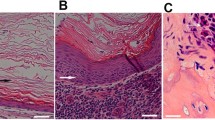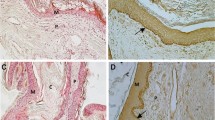Abstract
Locally produced pro-inflammatory cytokines are considered to play an important role in the initiation and/or maintenance of inflammatory diseases. In cholesteatomatous lesions there are increased levels of some cytokines and inflammatory mediators like interleukin 1, tumor necrosis factor and colony-stimulating factor, etc. Interleukin 6 (IL-6) can be produced by different cells present in cholesteatoma (e.g. keratinocytes, lymphocytes, fibroblasts and macrophages). Until now, no data have been available on the role of IL-6 in cholesteatoma. In this study we used immunohistochemistry to investigate the presence and distribution of IL-6 in tissue samples from cholesteatoma patients. Levels of the cytokine were quantified in tissue extracts using an enzyme-linked immunosorbent assay. Finally, the presence of biologically active IL-6 was analyzed in the murine cell line 7TD1. Human skin samples obtained from the external ear canal were used as controls. Using the anti-IL-6 antibody in an alkaline phosphatase anti alkaline phosphatase technique, a moderate diffuse staining of the whole epidermis was observed in sections of normal skin. In cryostat sections of cholesteatoma samples, a stronger staining of the whole epithelium was observed. Many of the cells infiltrating the cholesteatoma stroma also showed positive immunostainings. The concentration of IL-6 in relation to the total protein concentration in cholesteatoma (119.33 ± 30) were higher than in human skin (9.16 ± 13). While IL-6 activity was not detected in skin samples, two of the ten cholesteatoma samples studied showed a stimulatory effect when incubated with the cell line 7TD1. The overexpression of IL-6 in middle ear cholesteatoma suggests a participation of this cytokine in some of the clinical features seen: epithelial hyperproliferation and bone resorption. The absence of biological activity in the majority of the cholesteatoma samples points to the presence of natural inhibitors for IL-6.
Similar content being viewed by others
References
Aarden LA, De Groot ER, Schaap OL, Lansdorp PM (1987) Production of hybridoma growth factor by human monocytes. Eur J Immunol 17:1411–1416
Alm JM, Huang CC, Abramson M (1990) Interleukin-1 causing bone destruction in middle ear cholesteatoma. Otolaryngol Head Neck Surg 103:527–36
Black K, Garret IR, Mundy GR (1991) Chinese hamster ovarian cells transfected with the murine interleukin 6 gene cause hypercalcemia as well as cachexia, leukocyrosis and thrombocytosis in tumor-bearing nude mice. Endocrinology 128:2657–2659
Boxman I, Löwick C, Aarden L, Ponce M (1993) Modulation of IL-6 production and IL-1 activity by keratinocyte-fibroblast interaction. J Invest Dermatol 101:316–324
Bujía J, Holly A, Kim C, Schilling V, Kastenbauer E (1993) Neue Aspekte zur Pathogenese des Cholesteatoms: die m6gliche Rolle einer durch Immunzellen induzierten Keratinozyten-Hyperproliferation. Laryngorhinootologie 72:247–283
Bujia J, Holly A, Schilling V, Negri B, Pitzke P, Schulz P (1993) Aberrant expression of epidermal growth factor receptor in aural cholesteatoma. Laryngoscope 103:326–329
Bujía J, Schilling V, Holly A, Stammberger M, Kastenbauer E (1993) Hyperproliferation-associated keratin expression in human middle ear cholesteatoma. Acta Otolaryngol (Stockh) 113: 364–368
Content J, De Witt L, Poupart P, Opdenakker G, Van Damme J, Billiau A (1985) Induction of a 2-kDa-protein mRNA in human cells treated with an interleukin 1-related, leukocyte-derived factor. Eur J Biochem 152:253–258
Frei K, Leist TP, Meager A, Gallo P, Leppert D, Zinkernagel RM, Fontana A (1988) Production of B cell stimulatory factor-2 and interferon gamma in the central nervous system during viral meningitis and encephalitis. J Exp Med 168:449–453
Helle M, Boije L, Aarden LA (1988) Functional discrimination between interleukin 6 and interleukin l. Eur J Immunol 18: 1535–1540
Hirano T, Akira S, Taga T, Kishimoto T (1990) Biological and clinical aspects of inteleukin-6. Immunol Today 11:443–449
Huang T, Yan SD, Huang CC (1989) Colony-stimulating factor in middle ear cholesteatoma. Am J Otolaryngol 10:393–398
Hültner L, Moeller J (1990) Mast cell growth-enhancing activity (MEA) stimulates interleukin 6 production in a mouse bone marrow-derived mast cell line and a malignant subline. Exp Hematol 18:873–887
Ishimi Y, Miyaura C, Kin CH, Akatsu T, Abe T, Nakamura Y, Yamaguchi A, Yoshiki S, Matsuda T, Hirano T, Kishimoto T, Suda T (1990) IL-6 is produced by osteoblasts and induces bone resorption. J Immunol 145:3297–3303
Kohase M, Henriksen D, May LT, Vilcek J, Sehgal PB (1986) Induction of beta 2 interferon by tumor necrosis factor: a homeostatic mechanism in the control of cell proliferation. Cell 45:659–662
Matsuda T, Hirano T, Kishimoto T (1988) Establishment of an interleukin 6 (IL6)/B cell stimulatory factor 2-dependent cell line and preparation of anti-IL-6 monoclonal antibodies. Eur J Immunol 18:951–995.
May LT, Helfgott DC, Sehgal PB (1986) Anti-beta-interferon antibodies inhibit the increased expression of HLA-B7 mRNA in tumor necrosis factor-treated human fibroblasts: structural studies of the beta 2 interferon involved. Proc Natl Acad Sci USA 83:8957–8961
Mosmann T (1983) Rapid colorimetric assay for cellular growth and survival: application to proliferation and cytotoxicity assays. J Immunol Methods 65:55–60
Mundy GR (1993) Role of cytokines in bone resorption. J Cell Biochem 53:296–300
Palva T (1990) The pathogenesis and treatment of cholesteatoma. Acta Otolaryngol (Stockh) 109:323–330
Prens EP, Benne K, Van Damme J, Bakkus M, Brakel K, Benner R, Van Joost T (1990) Interleukin-1 and interleukin-6 in psoriasis. J Invest Dermatol 95:121S-124S
Roodman GD, Kurihara N, Ohsaki Y, Kukita T, Hosking D, Demulder A, Singer FR (1991) Interleukin 6: a potential autocrine paracrine factor in Paget's disease of bone. J Clin Invest 89:46–52
Schilling V, Negri B, Bujia J, Schulz P, Kastenbauer E (1992) Possible role of interleukin 1 alpha and interleukin 1 beta in the pathogenesis of cholesteatoma of the middle ear. Am J Otol 13:350–355
Schulz P, Bujia J, Holly A, Schilling V, Kastenbauer E (1993) Possible autocrine growth stimulation of cholesteatoma epithelium by transforming growth factor alpha. Am J Otolaryngol 14:82–87
Seghal PB (1990) Interleukin-6: molecular pathophysiology. J Invest Dermatol 94:2S-6S
Van Damme J, Opdenakker G, Simpson RJ, Rubira MR, Cayphas S, Vink A, Billiau A, Van Snick J (1987) Identification of the human 26-kD protein interferon beta 2 as a B cell hybridoma (plasmacytoma) growth factor induced by interleukin 1 and tumor necrosis factor. J Exp Med 165:914–920
Van Snick K (1990) Interleukin-6: an overview. Annu Rev Immunol 8:253–278
Van Snick K, Cayphas S, Vink A, Uyttenhove C, Coulie PG, Simpson RJ (1986) Purification and NH2-terminal amino acid sequence of a T-cell-derived lymphokine with growth factor activity for B-cell hybridomas. Proc Natl Acad Sci USA 83:9679–9683
Vink A; Coulie PG, Wauters P, Nordan RP, Van Snick K (1988) B cell growth and differentiation activity of interleukinHP1 and related marine planacytoma growth factors. Synergy with interleukin 1. Eur J Immunol 18:607–610
Wong GG, Clark SC (1988) Multiple actions of interleukin 6 within cytokine network. Immunol Today 9:137–141
Yan SD, Huang CC (1991) Tumor necrosis factor alpha in middle ear cholesteatoma and its effect on keratinocytes in vitro. Ann Otol Rhinol Laryngol 100:157–161
Yan SD, Huang CC (1991) Lymphotoxin in human middle car cholesteatoma. Laryngoscope 101:411–415
Yellon RF, Leonard G, Marucha P, Sidman J, Carpenter R, Burleson J, Carlson J, Kreutzer D (1992) Demonstration of interleukin 6 in middle ear effusions. Arch Otolarygnol Head Neck Surg 118:745–748
Yoshizaki K, Nishimoto N, Matsumoto K, Tagoh H, Taga T, Deguchi Y, Kuritani T, Hirano T, Hashimoto K, Okada N, Kishimoto T (1990) Interleukin 6 and expression of its receptor on epidermal keratinocytes. Cytokine 2:381–387
Author information
Authors and Affiliations
Rights and permissions
About this article
Cite this article
Bujía, J., Kim, C., Ostos, P. et al. Role of interleukin 6 in epithelial hyperproliferation and bone resorption in middle ear cholesteatomas. Eur Arch Otorhinolaryngol 253, 152–157 (1996). https://doi.org/10.1007/BF00615113
Received:
Accepted:
Issue Date:
DOI: https://doi.org/10.1007/BF00615113




